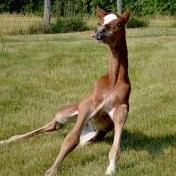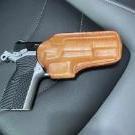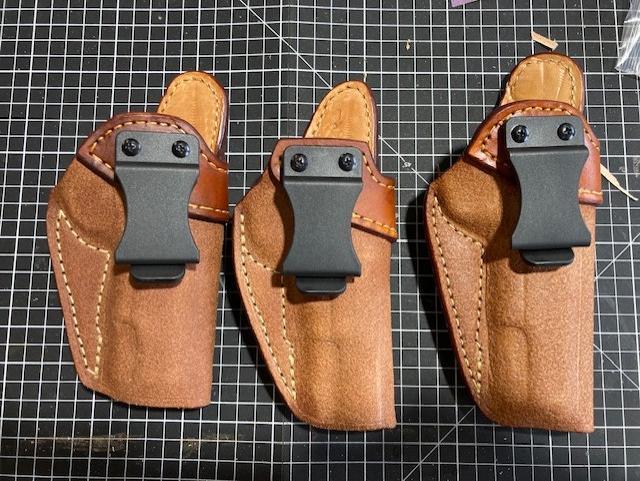All Activity
- Past hour
-
Tall Post Sewing Machines?
Cumberland Highpower replied to Cumberland Highpower's topic in Leather Sewing Machines
RockyAussie thanks for the reply. How do you find the overall ergonomics? Are these high posts comfortable machines to operate sitting down or do you feel your knees crowded and having to reach excessively upwards to work? Probably not as bad as I'm visualizing sitting here, but wanted to ask. Makes sense about the post offset. -
Leatherworking is a great winter hobby—quiet, creative, and very satisfying. You can definitely do it all by hand, no machines needed. People have made stunning leather goods by hand for centuries, so you're good to go with just basic tools and patience. I recommend "The Art of Hand Sewing Leather" by Al Stohlman (great for stitching techniques) and "Leatherworking Handbook" by Valerie Michael for a broader overview of tools, types of leather, and project ideas. Starter Tool Kit (for your projects): Knife: A skiving knife and a utility knife (like L’indispensable) will cover most tasks. Pricking irons (3.0–3.85mm) – better than chisels for finer work. Stitching awl and needles (John James) + waxed linen thread. Edge beveler (#2 or #3), edge creaser, adjustable groover, scratch awl – all very useful. Don’t forget a cutting mat, ruler, and burnisher (wood or bone). Look into European suppliers like Decocuir (France) or Le Prevo (UK) for quality tools without crazy shipping costs. And yeah, it’s true—finding a job nowadays can be tough in most fields unless you're using special services or platforms to boost your chances. So having a productive hobby like leatherwork is a solid idea!
-
This is the reality, and i agree completely. The sewing machine is one of the greatest inventions man has ever made IMO and the lock stitch has worked for a long time too.
- Today
-
That's just it a saddle stitch doesnt create a knot while a lockstitch is basicly a series of knots. Visualize your threads. Saddle stitching is basically using two threads spiraling them together with leather in between with no tension built by the threads pulling against each ohter. while lockstitch is two pieces of thread wrapped around each other in every hole, pulling against each the oposing thread on the other side of the leather
-
That's an interesting point, Chuck. It seems the ability to use a sewing awl is a dying art, driven in part by the ability to market expensive punches and irons. I've been an advocate for the efficiency, versatility and esthetics of awl sewing - holes always line up, can sew odd shapes that are difficult to punch, the hole size matches the thread. I'll add strength of the stitch to the list. Strength is tested on a regular basis with horse tack. I haven't seen many examples of failed stitching. It's usually the leather breaking where it wraps around hardware. I have seen linen thread rotted out after many years.
-
Man, those look sharp. Did you use Tokonole finish on the outside?
-
take one piece of thread and try and break it then, take two pieces of the same thread and try and break them. I will add saddle stitching into drilled round holes defeats the thread's ability to lock together, the leather slit and the tension it provides is part of the process that makes saddle stitching a stronger and better choice IMO.
-
Not really unless you dump the clutch like in a standard transmission truck. kgg
-
😄New word learnt. Couldn't pass up the opportunity to use it!
-
I'm still new to leatherworking. I have made about a dozen holsters, a few knife scabbards, and quite a few belts. I currently have a flatbed sewing machine, a Seiko CW8 Cylinder Arm Machine, and Weaver Cub, and hoping to acquire a Class 4 machine when practical. My question is regarding the Landis 5 in 1. Are these machines particularly useful in the realm of holster and scabbard building? A friend of mine is a retired boot repair shop owner and once told me how much he used the presser wheel which was good when gluing layered edges and I can see that in the boot resoling application but would that part of the 5 in 1 have any benefit with holsters and scabbards? I can see where the cutting wheel could make cleaner edges before beveling and finishing. 500 to 700 is a pretty substantial investment for me and I don't mind IF it's something I will use frequently. Thanks in advance.
-
Ashley’s Book of Knots contains brief instructions on how to tie this. See plates 1705 and 1706 on page 294. (For some reason, I could not paste a link, but search Ashley’s Book of Knots PDF for a free online copy.) I first saw this knot back in the 1970s when a leather worker named Rob McCall (one of the most creative, inspired & inspiring leatherworkers I’ve met) used it to attach the buckle to his belts and simultaneously form a triple keeper. He also used it as an adjuster on his handbag straps. If you see a leather piece signed Sparrow, it’s one of his.
-
I really love the old Harleys, Would love to have an old 1947 Knuckle Head. I told my good friends this old 1951 Landis 16 is my Knuckle Head lol.
-
Yes it did on the larger leather pieces it works out nice. The tote bags I use a 5 to 6oz and the leather that is soft or milled and this helps out. Its a game changer with this machine..
-
I might have some spare screws. Based in Germany. Actually your 105 has been rebuild to a 105-6 standart to work with a roller feet, does the presser feet rod have a flat and bolt hole? I might have also some feet.
-
Margorie joined the community
-
I had look yon up
-
I wish. I gotta hang about in case anything else needs moving
-
I haven't done many roughout holsters; there's definitely a knack to keeping the look clean and consistent. Larry
-
I love those belts! That is fantastic work! I really like he edge trim and stitching contrast.
-
Tall Post Sewing Machines?
RockyAussie replied to Cumberland Highpower's topic in Leather Sewing Machines
This following link shows the tall post machine I have. Note that the max thread size is 138. The needle goes into the right side which is good for allowing wide products that can be held out in the open left side if that makes sense. -
On the other-other hand, these digital servos suffer from low torque at low speeds. With enough reduction we can run the motor a little faster, where it might be a little happier and still have decent torque. If the machine will stand up to the torque of a clutch motor at 1700 rpm to 3400 rpm, I doubt even a torque increased servo is going to damage them. Now I need to go find out the torque put out by those old clutch motors. EDIT: So the rated torque of the clutch is about the same as the servo (which makes sense). But the giant spinning mass of that clutch motor has got to pack a pretty healthy wallop.
-
I've somewhat decided that I'd like a new machine, one kind of new to me anyway. A tall post. I've used a couple more standard post bed machines, and to be honest I prefer them over most any type. I've never used a "tall" or "extra tall" version. All I've seen have the bobbin/hook offset to the left as opposed to the right of the post. I'm wondering why that is? So far I've only seen Chinese machines for sale, I wonder if there are any good used machines that are EU/Japanese made? I'd like to run 138, but could go as high as 207 on top at times. Any recommendations?
-
What are y'all using to limit torque to your machines? So far all I've got is a loose belt.
-
My Take: Speed reduction is like a double edged sword. If you use a speed reducer for just reducing the machines sewing speed no harm will come to your machines internals. If you want / need the increase in torque to punch through something because of the additional available torque that a speed reducer will deliver. You run the risk of damaging / twisting internal parts that are not designed to take that load. The better option is then to invest in a different / better machine that is designed to handle that type of work. My attitude has always been if I need to use a speed reducer for additional torque benefits I am using the wrong machine. kgg












